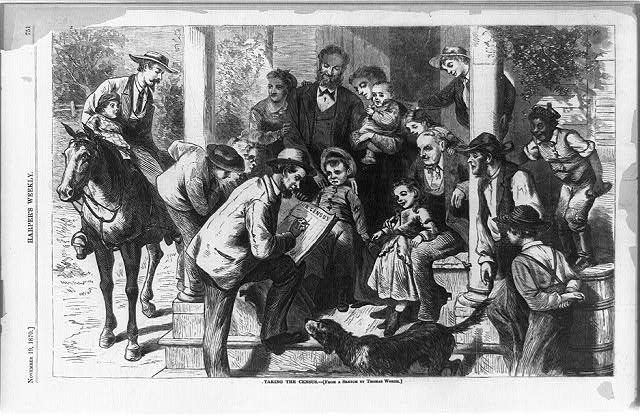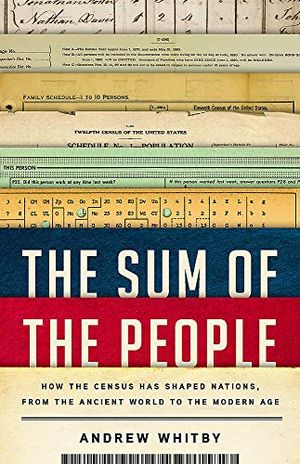The Enumerated Story of the Census
A new book charts the history of counting the public, from the ancient censuses in Rome to the American version of decennial data collection
/https://tf-cmsv2-smithsonianmag-media.s3.amazonaws.com/filer/f3/dd/f3dd2c02-8edf-4de4-a898-b8250bbbe05c/gettyimages-1144610283.jpg)
On January 21 of this year, Lizzie Chimiugak Nenguryarr, a 90-year-old elder in Toksook Bay, Alaska, became the first person to be counted in the 2020 Census. Workers from the U.S. Census Bureau and the agency’s director traveled to a rural corner of the state to kick off the decennial survey that helps apportion funds and representation. But just two months later, the Bureau paused all ground operations amid the outbreak of COVID-19—and has urged households to respond to the census online, by mail or by phone.
The Bureau doesn’t know yet how many people will respond to the survey or how successful the push to make the census primarily digital will be but the public can rest assured that the Census will go on, as it always has under Constitutional mandate. That is what drew Andrew Whitby, a data scientist and author of the new book The Sum of the People: How the Census Has Shaped Nations, from the Ancient World to the Modern Age, to studying and writing about the census.
“The core idea, that the government representing us reaches out to every single household in the nation and asks some basic questions, feels very democratic to me,” he told Smithsonian. “There's nothing that really matches it: not everyone votes, and not every household submits an income tax return. It's really the one time each decade that we pay attention to every single person living in this country.”
Whitby spoke with the magazine about early instances of record-keeping, how the U.S. survey has evolved and what the future might hold for the census.
The Sum of the People: How the Census Has Shaped Nations, from the Ancient World to the Modern Age
This three-thousand-year history of the census traces the making of the modern survey and explores its political power in the age of big data and surveillance
What’s the history of the census? What is the first recorded census and why did it come about?
It's hard to pinpoint a “first” census. The idea of formally counting people probably arose as soon as we started living together in communities large enough to require formal government and taxation—around, say, 5,000 years ago. Various mythological traditions describe censuses not long after that—one conducted by China's Emperor Yu, or by Moses in the Old Testament—but we can't take that as history.
The word “census” is Latin in origin, so in a linguistic sense, the first censuses were taken by the Romans, who were certainly doing this by around the middle of the first millennium B.C. But few if any of those counts would meet today's definition, which is essentially to count everyone in a given place at a given time. The biblical censuses, for example, excluded women—as did the Romans, as far as we know. There were, no doubt, small counts of villages or cities through history that would qualify, but today we mostly think about the census at a national level. So if you forced me to choose a first modern census I might pick that of Iceland in 1703, which recorded exactly 50,366 people and was about as accurate as a census today. That's nearly a century before the first U.S. census in 1790.
A lot of countries have censuses. What’s unique about the decennial census in the United States? Why was it seen as so essential during the nation’s founding?
First, the U.S. census is embedded in the Constitution itself—Article 1, Section 2—on a ten-year cycle. Whereas censuses in other countries might occur (or not) at the whim of a particular government, the U.S. census would go ahead every ten years no matter what (and since then, it has). Secondly, it was tied to a mechanistic, arithmetic approach to ensuring representative government, reapportioning Congress after each count. That was a novel idea. At the time the first U.S. census took place in 1790, Britain's Parliament suffered acutely from so-called “rotten boroughs”—unrepresentative districts with only a handful of voters. The U.S. had its own flaws, most notably the three-fifths compromise (which treated an enslaved person as three-fifths of a free person, for apportionment), but [the census] was sound.
Last year, we saw much debate about the inclusion of a citizenship question on the 2020 census, which was eventually struck down by the Supreme Court. How has the census been politicized before?
Statisticians would love for the American census to be an objective, scientific instrument, but that very innovation, to use it for apportionment, prevents it from ever being so. Censuses have consequences for the distribution of power, so censuses attract political scrutiny. After the 1920 census—the first in which a majority of the population was urban—Congress failed its constitutional duty to reapportion itself, as rural states opposed the loss of power that would have entailed. It wasn't until 1929 that a law was passed making apportionment automatic, as it is today.
With the civil rights era, other more egregious wrongs in the American electoral system were gradually rectified, and so even more attention focused on the census itself. Since about the 1970s, seemingly arcane questions of methodology have often been settled in the courts, as with the now-rejected citizenship question.
How have Americans’ changing concept of privacy affected the census?
In the early days, some people saw the census as an intrusion, an illiberal imposition, but they didn't really have the language of privacy to describe that. The first inklings of privacy arose in respect of commercial statistics the census began to collect in 1820; businesspeople were worried that their competitors might learn their secrets. It was really in the late 19th and early 20th century that our current notion of privacy crystalized. The census—which was asking ever-more personal questions—responded by adopting a commitment to secrecy. As President Taft declared in 1910, no person can “be harmed in any way by furnishing the information required.” There have been lapses since, especially during times of war, but that is still the guiding principle.
I learned from your book that we have a census-worker to thank for early computing machines. How has innovation changed the census?
The logistics of reaching everybody and collecting their responses was always a challenge—and it continues to be. But for a long time, the compilation and analysis of responses was difficult, too. Thousands of clerks were employed to copy and condense this information, just to make a single table in a census publication. It's hard to imagine anything else in the 19th century that compares to it: the census was the original Big Data.
But as the number of questions and the population grew, this became increasingly difficult. After the 1880 U.S. census, a real effort was made to find a better way of doing things. One bright young former census agent, Herman Hollerith, invented a machine to tabulate results by first encoding them in punch cards and then feeding those cards through an electric machine. It wasn't a computer, but the technology of punch cards underpinned computing up into the 1970s, and the company Hollerith founded eventually became IBM.

I was surprised when filling out the census recently that it only included 9 questions. Previous iterations had dozens and dozens of questions. What accounts for that change? Where are governments getting the other information?
First, well done on responding! It’s interesting that you were surprised—and you're not the only one who has said that to me. The core census—the set of questions asked of every household—has been very short since about 1970, never asking more than about ten questions. That was an intentional change from the earlier period. The Census Bureau became increasingly aware that it was missing people, and it is a general rule in survey statistics that the shorter the survey, the more likely people will respond. So the Bureau really streamlined things.
What you might be remembering is that up to 2000, the census sent a "long form" questionnaire with additional questions to a random sample of households (1 in 6 in 2000). In 2005, the Census Bureau replaced the long form with the American Community Survey (ACS), which is administered continuously throughout the decade. Only 3.5 million households are asked to complete the ACS each year, so you're quite lucky if you encounter it!
What does the future of the census look like? Does it still matter in the 21st century?
Quite a few countries no longer perform a traditional enumeration, but instead maintain a live register of their entire population. That requires a population that is willing to notify the authorities every time, for example, that they move homes. It looks like an increasing number of countries are headed in that direction, though I'm not sure it could happen in the U.S. anytime soon, not least because the census is mandated by the Constitution.
Does the census still matter? Can you have sensible government on the basis of facts without something like a census (be that a decennial enumeration or a population register)? I don't think so. The census generates the population denominators in so many of the statistics that we depend upon to understand our society. Now more than ever, we're seeing how important good data is. How much should we worry about 100 deaths from a new disease? Amongst other things, that depends very much on whether they occur in a town of 5,000 or a city of 8 million.
How will COVID-19 affect this census?
Like everything related to COVID-19, it's currently very hard to know. Concretely, the Census Bureau has now delayed its "field operations" for a month. That is less of a problem than it sounds, because they were always planning to encourage the majority of households to reply online (or by mail or phone). As of “Census Day,” April 1, nearly 40 percent had already done that. All the official communications from the Bureau express optimism and reiterate the goal of counting everyone.
But short of a miracle, a large number of households—around 50 million in 2010—will not self-respond, and so will need to be enumerated in what the Bureau calls "nonresponse follow-up" operations. That usually requires field work—knocking on doors, interviewing occupants in person. That can only be delayed so far before it must run up against the due date for delivery of initial numbers, which is December 31, 2020. And of course, the later field work happens, the lower the quality of responses, since you're asking people to remember “Who lived here on April 1?”
So everything depends on whether the current [COVID-19] conditions persist for a month, six months, a year.
A Note to our Readers
Smithsonian magazine participates in affiliate link advertising programs. If you purchase an item through these links, we receive a commission.
